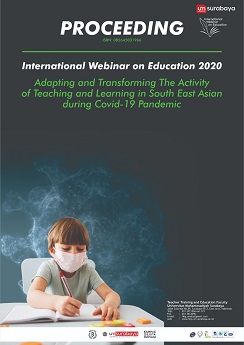Expanding Language Development Among Children And Communication Disorders
Abstrak
Abstract :
Language development disorder is the inability or limitations in using linguistic
symbols to communicate verbally or delays in children's speech and language development abilities according to their age group, gender, customs and intelligence. Therefore, if speech and base disorders are not treated properly, there will be impaired reading ability, verbal ability, behavior, psychosocial adjustment, and poor academic ability. Parents or teachers need to understand this problematic behavior because "problematic children" usually appear in the classroom and they even show the problem in their behavior during interaction with the environment. Humans use language to communicate, socialize, and convey their thoughts. Early identification of language delays must solve two main problems namely the problem of the availability of reliable information from a child at some age when they experience limitations in communication skills. Furthermore, measurement techniques must be cost-effective by respecting time in a professional manner and widely able to be applied to children at various social levels and language backgrounds including bilingual. The second problem is the interpretation of the results of the identification process. Many children who experience language delays at the age of 24 to 30 months who will catch up in a few years later and do not need intervention. The challenge is to identify and use relevant information in improving diagnosis decisions regarding an individual child to prevent more significant developmental disorders.
Keywords: language, communication, children
Referensi
Autism Society of America. (2007). Defining autism. www.autismsociety.org. Retrieved August 6, 2007.
Bishop, D. (1997). Uncommon understanding: Development and disorders of language comprehension in children. Hove. East Sussex. UK; Psychology Press.
Bishop, D. (20006). What causes specific language impairment in children? Current Directions in psikological Science, 15(6). 217-221.
Brown, M., &Kaibli, J. (1997). Facilitating the socializationof childrenwith autism. Early Childhood Education Journal, 24 (3), 185-189.
Cook, R., Tessier, A., & Armbruster. V. (1987). Adapting early childhood curricula for chilsren with special needs (2nd ed.). Upper Saddle River Nj: Merrill/Prentice Hall.
Cullata, R., & Looper, l. (1987). Disfluency in childhood: It‘s not always stuttering. Journal of Childhood Conimmunication Disorders, 10 (2), 95-106.
Fey, M. Long, S., & Finestack, L. (2003, February). Ten Principles of grammar facilitation for children with specific language impairment, american Journal of Speec
Language Pathology, 12. 3-15.
Goin, R., & Myers, B. (2004, spring). Characteristics of infantile autism: Moving toward earlier detection. Focus on Autism and Other Developmental Disabilites, 19 (1). 5-12.
Gottwald, S., Goldbach, p., &Isack, A (1985). Stuttering: Prevention and delection. Young Children, 41 (1). 9-16.
Geenspan, S. (1997). the growth of the mind and the andangered origins of intelegence. Reading, MA: Perseus Books.
Marschark, K. (1997), Raising and educating a deaf child. New York: Oxford University Press.
Mastropieri, M., & Scrunggs, T. (2007). The inclusive classroom: Strategies for effective instruction (3rd ed.). Upper Saddle River, Nj:Pearson/Merill/Prentice Hall.
Moller, K., Starr. C., & Johnson. & (1990). A parent's guide to celft lip and palate. Minneapolis: University of Minnesota Presss.
Montgomery, J. (2002. February). Understanding the language difficulties of children with specific language impairments: Does verbal working memory matter? American
Journal of speech-language Pathology. 11, 77-91.
Patterson, K., & Wright, A. (1990). The speech, language or hearing-impalred child: Atrisk academically. Childhood Education, 67 (2), 61-95.
Ratner, N. (2009). Atypical language development. In J. Berko Gleason & N. Berstein Rather (Eds.), The development of language (7th ed., pp. 315-390), Boston: Pearson/ALLYN & bACON.
Roizen, N. (2003). Nongenetic causes of hearing loss. Mental Retardation and Developmental Disabilities Research Reviews, 9, 120-127.
Watson, I., Baranek, G., & Dil avore, P (2003). Teddlers with autism: Developmental perspective. Infants and Young Children, 16 (3), 201-214.
Weir, E., & Bianchet, S. (2004). Developmental dysfluency: Early intervention is key. Canadian Medical Association Journal, 170 (12), 1790-1791.
Wimpory, D., Hobson, R., Williams, J., & Nash, S. (2000). Are infants with autism socially engaged? A study of recent retrospective parental repost. Journal of Autism and Developmental Disorders. 30 (6). 525-536






